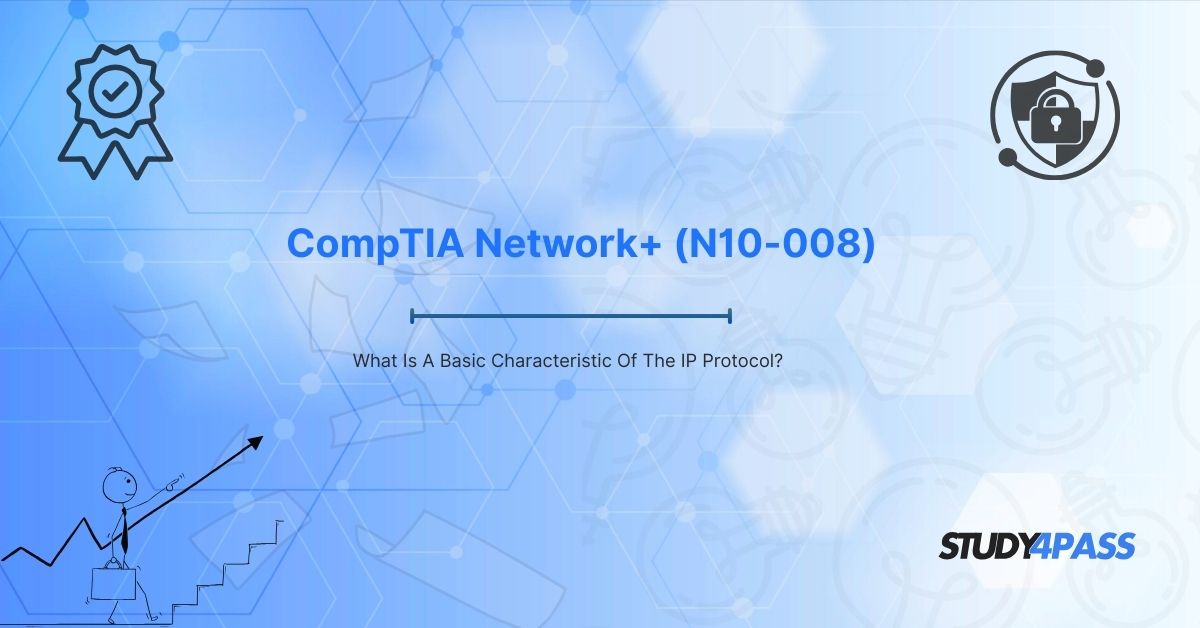Introduction
The Internet Protocol (IP) is a fundamental component of modern networking, serving as the backbone for data communication across the internet and private networks. Understanding the basic characteristics of the IP protocol is essential for anyone pursuing the CompTIA Network+ N10-008 certification. This article explores the core features of IP, its role in networking, and how mastering these concepts can help you succeed in your certification exam.
For those preparing for the CompTIA Network+ N10-008 exam, Study4Pass offers comprehensive study materials, practice tests, and expert guidance to ensure success. Visit Study4Pass for the best resources to ace your certification.
Understanding the IP Protocol
Definition of IP (Internet Protocol)
The Internet Protocol (IP) is a network-layer protocol responsible for addressing and routing packets across networks. It enables communication between devices by assigning unique IP addresses and ensuring data reaches its intended destination.
Role of IP in the OSI and TCP/IP Models
- OSI Model: IP operates at Layer 3 (Network Layer), handling logical addressing and routing.
- TCP/IP Model: IP is part of the Internet Layer, working alongside protocols like ICMP and ARP.
Basic Characteristics of the IP Protocol
Connectionless Communication
- IP is a connectionless protocol, meaning it does not establish a dedicated end-to-end connection before transmitting data.
- Each packet (datagram) is treated independently, which increases efficiency but does not guarantee delivery.
Best-Effort Delivery
- IP does not ensure that packets arrive at their destination.
- Reliability is handled by higher-layer protocols like TCP (Transmission Control Protocol).
Packet Switching
- Data is divided into smaller packets that travel independently across the network.
- Packets may take different routes and arrive out of order, requiring reassembly at the destination.
IP Addressing
- Every device on an IP network has a unique IP address (e.g., IPv4: 192.168.1.1, IPv6: 2001:0db8:85a3::8a2e:0370:7334).
- IPv4 uses 32-bit addresses, while IPv6 uses 128-bit addresses to accommodate more devices.
Fragmentation and Reassembly
- If a packet is too large for a network segment, IP can fragment it into smaller pieces.
- The receiving device reassembles the fragments into the original packet.
Time-to-Live (TTL)
- Each IP packet has a TTL value that decreases with each router hop.
- If TTL reaches 0, the packet is discarded to prevent infinite loops.
No Built-in Error Correction
- IP does not provide error-checking or recovery mechanisms.
- Higher-layer protocols (e.g., TCP) handle error detection and retransmission.
Support for Multicast and Broadcast
- Unicast: One-to-one communication.
- Multicast: One-to-many communication (e.g., video streaming).
- Broadcast: One-to-all communication within a network (e.g., ARP requests).
IPv4 vs. IPv6: Key Differences
|
Feature |
IPv4 |
IPv6 |
|
Address Length |
32-bit (4.3 billion addresses) |
128-bit (340 undecillion addresses) |
|
Header Size |
20-60 bytes (variable) |
40 bytes (fixed) |
|
Security |
Relies on add-ons (IPSec optional) |
Built-in IPSec |
|
Address Configuration |
Manual or DHCP |
Auto-configuration (SLAAC) |
|
Fragmentation |
Done by sender and routers |
Only by sender |
Importance of IP in CompTIA Network+ N10-008 Exam
The CompTIA Network+ N10-008 exam tests your knowledge of networking fundamentals, including IP addressing, subnetting, and routing. Key topics include:
- IP addressing schemes (IPv4 & IPv6)
- Subnetting and CIDR notation
- Routing protocols (RIP, OSPF, BGP)
- Troubleshooting IP connectivity issues
To master these concepts, Study4Pass provides:
- Detailed study guides
- Interactive practice exams
- Real-world lab simulations
- Expert-led video tutorials
Enhance your exam preparation with Study4Pass today!
Common IP-Related Network Issues & Troubleshooting
IP Address Conflicts
- Occurs when two devices have the same IP.
- Solution: Use DHCP or manually assign unique addresses.
Incorrect Subnet Mask
- Leads to communication failures.
- Solution: Verify subnet settings and adjust if necessary.
Default Gateway Misconfiguration
- Prevents communication outside the local network.
- Solution: Ensure the correct gateway IP is configured.
DNS Resolution Problems
- Devices cannot resolve domain names to IPs.
- Solution: Check DNS server settings or use alternative DNS (e.g., Google DNS: 8.8.8.8).
Conclusion
Understanding the basic characteristics of the IP protocol is crucial for network professionals and CompTIA Network+ N10-008 candidates. From connectionless communication to packet switching and IP addressing, these concepts form the foundation of modern networking.
For the best exam preparation resources, visit Study4Pass, where you’ll find expert-curated materials to help you pass with confidence!
Special Discount: Offer Valid For Limited Time “N10-008 Exam Prep Practice Test”
Sample Questions for CompTIA N10-008 Exam Prep Practice Tests
Actual exam questions from CompTIA's Network+ N10-008
1. Which of the following is a basic characteristic of the IP protocol?
a) Guaranteed delivery of packets
b) Connection-oriented communication
c) Best-effort delivery (no reliability guarantee)
d) Error correction and retransmission
2. IP operates at which layer of the OSI model?
a) Data Link Layer
b) Transport Layer
c) Network Layer
d) Application Layer
3. What does the IP protocol primarily use to route packets across networks?
a) MAC addresses
b) Port numbers
c) IP addresses
d) Session IDs
4. Which of the following is NOT a feature of the IP protocol?
a) Packet fragmentation and reassembly
b) End-to-end encryption
c) Addressing and routing
d) Supports both IPv4 and IPv6
5. Why is IP considered a connectionless protocol?
a) It establishes a handshake before sending data
b) It does not require a pre-established path for communication
c) It guarantees packet delivery
d) It only works within a local network


